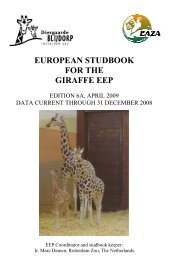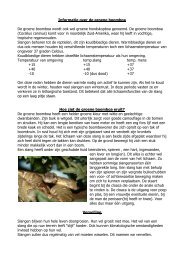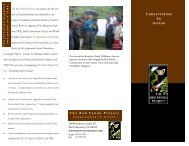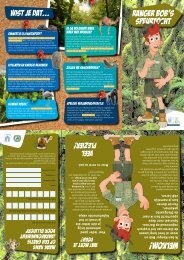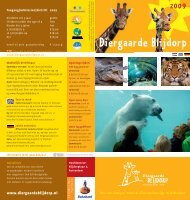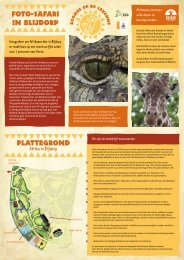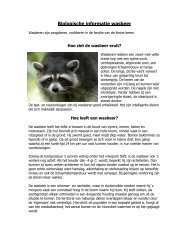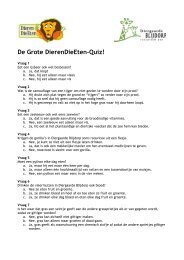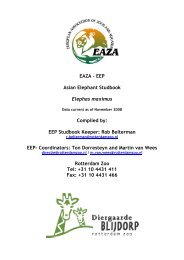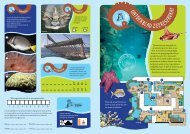Create successful ePaper yourself
Turn your PDF publications into a flip-book with our unique Google optimized e-Paper software.
<strong>EEP</strong> STUDBOOK CROWNED PIGEONS<br />
Bio-geography<br />
The native mammal fauna of the island if New Guinea is depauperate, meaning that many<br />
kinds of mammals found in adjacent regions of the world are lacking here. New Guineas<br />
mammal fauna is made up, apart from flying foxes and other kinds of bats, of two kinds of<br />
monotremes, and approximately an equal <strong>number</strong> (around 60) of species of marsupials<br />
(pouched mammals) and rodents but this conceals the fact that the marsupials are far more<br />
diverse. Rodents are represented by just one family: rats and mice (Muridae). On the other<br />
hand there are seven families of marsupials ranging from tiny mouse-sized carnivores to<br />
large, herbivorous kangaroos. In Australia the composition of the endemic terrestrial<br />
mammalian fauna is just the same: monotremes, marsupials and rodents, but the rats and mice<br />
are now quite out<strong>number</strong>ed by more than 120 species of marsupials in 13 separate families.<br />
There are six different families of bats in New Guinea as well but bats have fewer restrictions<br />
on their movements and many kinds are very widely distributed outside the region. Among<br />
the introduced mammals the most important is the pig which has been around for so long that<br />
it is often thought to be a native animal. It is almost certain that pigs were brought in to New<br />
Guinea by the earliest human arrivals, possibly over more than 15.000 years ago. In more<br />
recent times, the native fauna has been augmented by dogs, which exists as truly wild<br />
populations in some areas cats are a relatively recent introduction as well as various kinds of<br />
deer and, unwittingly, black and brown rats and house mice (Menzies, 1991).<br />
History<br />
The mainland of Papua New Guinea, where the bulk of all animal and plant life is found, has<br />
served as a distribution center for the islands: the Bismarck Archipelago is being colonised<br />
mainly by adventurous New Guinea birds which used the various islands as stepping stones.<br />
Due to isolation a <strong>number</strong> of these birds evolved into distinct species (Coates, 1977).<br />
For one or more periods during the ice ages when sea levels were much lower than they are<br />
now, Australia was actually joined to New Guinea and final separation only came less than<br />
one million years ago, with the formation of the Torres Strait (Menzies, 1991).<br />
In New Guinea several different geographical subregions can be distinguished, each with<br />
some characteristic flora and fauna.<br />
The region that is most obviously different from the rest of New Guinea is the southern<br />
woodland or savanna country, which includes many elements of the Australian fauna. This<br />
region includes the plains of the southern Fly and Digul Rivers, a narrow coastal strip east and<br />
west of Port Moresby and some scattered patches on the SouthEast coasts. The animals found<br />
here are all common in north Queensland (Australia) and their presence in New Guinea is a<br />
relic of the time when Australia and New Guinea were one land mass, before the Torres Strait<br />
was formed. Relatively few species are found in both savanna and forest.<br />
Most of the rest of New Guinea is covered by tropical rain forest of one sort or another and<br />
can be divided into different zones, the exact boundaries of which vary from place to place<br />
according to local climate and topography. Lowland forest from sealevel to about 600 m is<br />
often subject to inundation. Hill forest on slopes up to 1000 or 1200 m has a similar<br />
composition but is not subject to inundation in wet weather. Lower montane forest (1200 to<br />
2000 m), mid-montane forest (2000 to 3000 m) and upper montane forest above 3000 m<br />
follow but upper montane forests tend to occur in patches interspersed with open vegetation<br />
123



